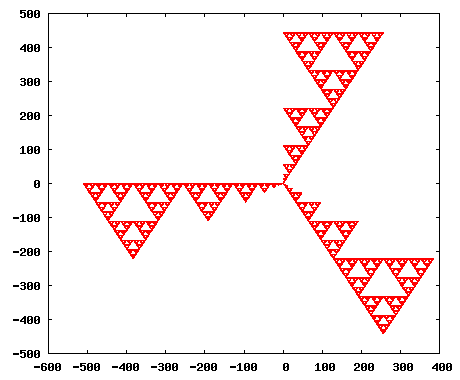The New York Times published a short but good article about Emmy Noether yesterday.![]()
SQL and noSQL Can Be Thought of as Duals in the Mathematical Sense
 This month’s Communications of the ACM (Association for Computing Machinery) has an interesting article which explains how SQL databases and noSQL databases are duals of each other in the Category Theoretical sense.
This month’s Communications of the ACM (Association for Computing Machinery) has an interesting article which explains how SQL databases and noSQL databases are duals of each other in the Category Theoretical sense.
MoMath
 Did you know that there is a museum of mathematics? I didn’t know either, but now that I regularly get junk from the AMS (American Mathematical Society), I recently learned that there is a museum dedicated to math!
Did you know that there is a museum of mathematics? I didn’t know either, but now that I regularly get junk from the AMS (American Mathematical Society), I recently learned that there is a museum dedicated to math!
The new Museum of Mathematics will open in Manhattan in early 2012; see http://www.momath.org. MoMath has the enthusiastic support of notables such as actor, director, and science buff Alan Alda, among others. MoMath is showing the fun of math at the upcoming U.S. Science & Engineering Festival and in its traveling Math Midway http://www.mathmidway.org. In the coming months, the Math Midway will travel to Texas, California, Ohio and Maryland.
Books: “A Mathematician’s Lament” by Paul Lockhart

Anybody who teaches math should read this book!
This book perfectly summarizes my disgust with the state of “education” today. The author’s main thesis is that math is an art that should be taught in a way to cultivate appreciation and understanding. It is not merely a set of formulas and definitions that students should commit to memory. Here is a quote from page 29:
By concentrating on what, and leaving out why, mathematics is reduced to an empty shell. The art is not in the “truth” but in the explanation, the argument. It is the argument itself which gives the truth its context, and determines what is really being said and meant. Mathematics is the art of explanation. If you deny students the opportunity to engage in this activity— to pose their own problems, make their own conjectures and discoveries, to be wrong, to be creatively frustrated, to have an inspiration, and to cobble together their own explanations and proofs—you deny them mathematics itself. So no, I’m not complaining about the presence of facts and formulas in our mathematics classes, I’m complaining about the lack of mathematics in our mathematics classes.
And another choice quote about the evils of High School Geometry from page 67:
…never was a wolf in sheep’s clothing as insidious, nor a false friend as treacherous, as High School Geometry. It is precisely because it is school’s attempt to introduce students to the art of argument that makes it so very dangerous.
Posing as the arena in which students will finally get to engage in true mathematical reasoning, this virus attacks mathematics at its heart, destroying the very essence of creative rational argument, poisoning the students’ enjoyment of this fascinating and beautiful subject, and permanently disabling them from thinking about math in a natural and intuitive way.
The mechanism behind this is subtle and devious. The student-victim is first stunned and paralyzed by an onslaught of pointless definitions, propositions, and notations, and is then slowly and painstakingly weaned away from any natural curiosity or intuition about shapes and their patterns by a systematic indoctrination into the stilted language and artificial format of so-called “formal geometric proof.”
This book is available as a freely downloadable PDF.
Einstein’s Happiest Thought…Doomed?
 When Albert Einstein first realized that gravitational mass and inertial mass were the same thing, the resulting thoughts led him to expand the theory of special relativity into general relativity. He called this equivalence of gravitational mass and inertial mass the “Equivalence Principle”, and called it his “happiest thought”. Recent calculations posted in a paper on the arXiv, assert that this is not true at the quantum scale. The most important aspect of this research is that it should be experimentally verifiable. At least that is what the author of the Physics ArXiv Blog thinks.
When Albert Einstein first realized that gravitational mass and inertial mass were the same thing, the resulting thoughts led him to expand the theory of special relativity into general relativity. He called this equivalence of gravitational mass and inertial mass the “Equivalence Principle”, and called it his “happiest thought”. Recent calculations posted in a paper on the arXiv, assert that this is not true at the quantum scale. The most important aspect of this research is that it should be experimentally verifiable. At least that is what the author of the Physics ArXiv Blog thinks.
Innumeracy
Innumeracy or stupidity…you decide.
SET! Puzzle now available on NYTimes.com
Stephen Chu’s White Roof Proposal and Rush Limbaugh’s Response

White roofing on urban row homes in Philadelphia
I feel that anybody who has completed a high school education in this country should be able to come up with the explanation that I just gave above, but the sad fact is that probably the majority of American’s could not give such an explanation, despite the fact that the overwhelming majority of Americans have completed high school. Science has been the hallmark of the advancement of all civilizations, why is “illiteracy” in science (and innumeracy) so acceptable in our society? Although left wing extremists will jump at the opportunity to make Rush look stupid, the general public won’t care. Although it is possible that Rush was being disingenuous and really did understand the simple ideas behind the proposal, but feigned ignorance for political reasons, I am more inclined to believe that he was being honest when he said he didn’t understand how it works.
We really need to look at how we teach in this country, and start experimenting with radical new approaches because this perfectly illustrates how inadequate current methods are. I realize changes in how science is taught have been made since Mr. Limbaugh attended school, but I am quite certain that most recent graduates would respond similarly.
Books: “Euler’s Gem The Polyhedron Formula and the Birth of Topology” by David S. Richeson

This book is a beautifully illustrated gem! It examines Euler’s famous formula: V-E+F=2 which holds for all polyhedra or surfaces which are topologically equivalent to the sphere. The formula is an example of a topological invariant, something which can be computed for any surface, and thus allows one to categorize surfaces. The book also covers the famous classification theorem which categorizes all surfaces as either homeomorphic (topologically equivalent) to a sphere, n-handled torus, or sphere with n cross-caps (projective plane). Next it dives into knot theory and Seifert surfaces, before moving on to the interplay between topology and geometry, and ends by mentioning homology and how topology is done in higher dimensions.
Steven Strogatz guest blogs on the New York Times
 Steven Strogatz, a mathematician at Cornell University and the author of a really cool book on chaotic dynamical systems was asked to guest blog at the New York Times today. He has written a short but interesting piece about power laws originating in biological systems and even in cities.
Steven Strogatz, a mathematician at Cornell University and the author of a really cool book on chaotic dynamical systems was asked to guest blog at the New York Times today. He has written a short but interesting piece about power laws originating in biological systems and even in cities.
Creating Printable PDF Flash Cards Using LaTeX
This post details how to make high quality, printable flash cards like I have available at my web site. I am assuming you are using Ubuntu Linux. I did this on Ubuntu 8.04 (Hardy Heron), but it might work on some previous and later versions as well.
First you want to install LaTeX, plus Andrew Budge’s flashcards package. Open a command terminal and type in the following command to install TeX and LaTeX. The flashcards package resides in the texlive-latex-extra Ubuntu package.
$ sudo apt-get install texlive texlive-latex-extra
I also recommend installing Kile which is a great program for editing TeX/LaTeX documents. You can do this with the following command. Depending on your system configuration, apt-get might require you to install several extra packages. The following is optional:
$ sudo apt-get install kile
At this point, if you try to compile a latex document that uses the flashcards package, you’ll get the following error:
! Package geometry Error: You must set \paperwidth properly.
To fix this, we need to create a small file called geometry.cfg, which tells the geometry packages which type of paper we will be using. Create the file using the following command:
$ sudo gedit /usr/share/texmf-texlive/tex/latex/geometry/geometry.cfg
Now copy and paste the following into gedit, save the file and exit from gedit.
%%
%% This is file `geometry.cfg',
%% generated with the docstrip utility.
%%
%% The original source files were:
%%
%% geometry.dtx (with options: `config')
%%
%% File: geometry.dtx Copyright (C) 1996-2002 Hideo Umeki
%% (hideo.umeki@toshiba.co.jp)
%%
%% This package may be distributed under the terms of the LaTeX
%% Project Public License, as described in lppl.txt in the base
%% LaTeX distribution, either version 1.2 or (at your option)
%% any later version.
%%
%% Uncomment and edit the line below to set default options.
\ExecuteOptions{letterpaper,dvips}
\endinput
%%
%% End of file `geometry.cfg'.
Now, you should be able to compile a LaTeX document that uses the flashcards package without errors, but there will be some warnings. To fix the warnings, we need to change one line in flashcards.cls.
$ sudo gedit /usr/share/texmf-texlive/tex/latex/flashcards/flashcards.cls
The following diff command shows the change you need to make:
$ diff -ru flashcards.cls.bak flashcards.cls
--- flashcards.cls.bak 2009-01-26 17:15:27.000000000 -0700
+++ flashcards.cls 2009-01-26 19:43:57.000000000 -0700
@@ -83,7 +83,7 @@
top=\topoffset,
left=\oddoffset,
right=\evenoffset,
- twosideshift=\oddevenshift,
+ twoside=true,
bottom=0.0in,
noheadfoot}
\ifthenelse{\boolean{flashcards@dvips}}{\geometry{dvips}}{}
Now you should be able to compile a LaTeX document without any errors or warnings, excepting for any errors in your own markup of course.
Good Introduction to Emacs
 I stumbled upon a short but useful introduction to emacs on the web. It has lots of screenshots to demonstrate the different commands. It even touches upon development tools like gdb and diff.
I stumbled upon a short but useful introduction to emacs on the web. It has lots of screenshots to demonstrate the different commands. It even touches upon development tools like gdb and diff.
Books: “Particle Physics A Very Short Introduction” by Frank Close

I found this book in the library the other day and found it to be a very good introduction to the basics of particle physics. I liked the fact that it explains the basics of the experimental side of particle physics as well as introducing the three families of leptons and quarks. Too often, popular science books explain the various subatomic particles with out giving you any idea of how we actually know of their existence. Because of this, I think disbelief tends to creep in. But Close does an excellent job of explaining the basics of how accelerators operate and also the basics of how detectors work. And he does all this in only 129 pages! Very short indeed, and highly recommended.
Algebraic Geometry: “Ideals, Varieties, and Algorithms” C++ Code
 I did an REU (Research Experience for Undergraduates) this summer and we used the textbook “Ideals, Varieties, and Algorithms” (isbn 978-0-387-35650-1) by David Cox, John Little, and Donal O’Shea. As the title mentions, algorithms are an important tool in the study of varieties via their corresponding algebraic ideals. One of the main tools used in algebraic geometry is what is known as a Groebner basis, which is somewhat akin to a basis set in Linear Algebra. Anyway, I wrote some C++ code which implements a few of the algorithms in the book, but stops short of implementing Buchberger’s algorithm for computing a Groebner basis. The code should be useful as a starting point because it implements a Monomial class and a Polynomial class both with lots of useful methods thus eliminating the drudgery of implementing the book’s algorithms in C++.
I did an REU (Research Experience for Undergraduates) this summer and we used the textbook “Ideals, Varieties, and Algorithms” (isbn 978-0-387-35650-1) by David Cox, John Little, and Donal O’Shea. As the title mentions, algorithms are an important tool in the study of varieties via their corresponding algebraic ideals. One of the main tools used in algebraic geometry is what is known as a Groebner basis, which is somewhat akin to a basis set in Linear Algebra. Anyway, I wrote some C++ code which implements a few of the algorithms in the book, but stops short of implementing Buchberger’s algorithm for computing a Groebner basis. The code should be useful as a starting point because it implements a Monomial class and a Polynomial class both with lots of useful methods thus eliminating the drudgery of implementing the book’s algorithms in C++.
The code can be found at: my web site as a gzipped tarball. Please let me know if you find it useful. I developed the code on an Ubuntu Linux machine, but it is generic enough that it should compile on any platform. You will need to read the README to understand the simple input, output format.
Run any GNU/Linux app on Windows without any virtualization
Free Software Magazine has an excellent article on how to Run any GNU/Linux app on Windows without any virtualization.
It explains how to install, setup and use the free Xming X Window server for Windows and also how to use SSH from the command line. It also includes information on how to enable SSH access into an Ubuntu machine.
Iterated Function Systems and Fractals
This code generates fractals based upon an iterated function system (IFS). Several input files and a Makefile are included. The code is written in C++, and distributed as a tarball. I did this for a class at the University of Utah, but it is based upon a homework assignment for a computer graphics class at MIT (6.837).
Below is the famous Barnsley fern which was generated by an IFS with just four transforms!

New and Improved Sierpinski Triangle C++ Code
I modified my Sierpinski triangle code so that it now allows you to adjust the contraction mapping constant. Normally one uses a contraction mapping constant of 1/2 but if you invert that and instead use an expansion mapping constant of 2, then you get the following pretty picture.

The New College Try – New York Times
The New York Times has an excellent op-ed piece today on college admissions. Read the article, and you’ll see why test prep centers like Kaplan are doing so well.
Strategy Letter VI – Joel on Software
Joel Spolsky has an excellent essay on his blog about AJAX web apps and where they’re headed. The essay is entitled Strategy Letter VI – Joel on Software and I highly recommend it!
I used to be very enthusiastic about a startup that originated at MIT called Curl Corporation that did much of what Joel talks about with one major exception, instead of targeting JavaScript, they targeted their own runtime. Now that has the major disadvantage that users must download the runtime in order to run client-side Curl code, but the widespread adoption of Flash (which sucks in comparison because it was designed for visual effects) leads me to believe that if they had decided to freely distribute their runtime (for commercial as well as non-commercial use), then they would be rulers of the web by now. Their language is fairly Lispy like Joel talks about in his essay, and was a joy to use, but alas, they decided to take the short-term route and market their technology to large corporations for intranet applications. I tend to think that if they had taken the long-term strategy of targeting the entire web, then we would all be using Curl now and enjoying very rich client-side web apps instead of bickering about how to best AJAXify your web-site/application.
At this point in time, I think Joel is spot-on about the need to target JavaScript, instead of creating a new runtime, because that avoids the chicken and egg dilemma. But the devil is in the details. It may be a considerable challenge to seamlessly target Microsoft’s, Apple’s and Mozilla’s JavaScript engines.
Classes I’m Taking Fall Semester 2007
Here are the classes I’m taking this fall:
- Introduction to Complex Analysis
- Introduction to Topology
- Research Experience for Undergraduates: Metric Spaces, The Contraction Mapping Principle, Fractals and Other Applications
